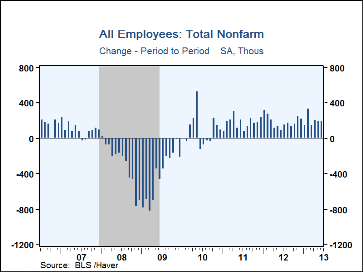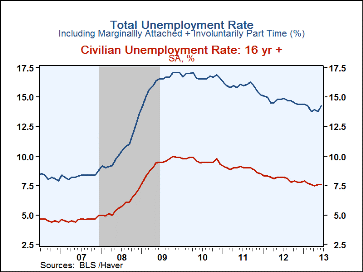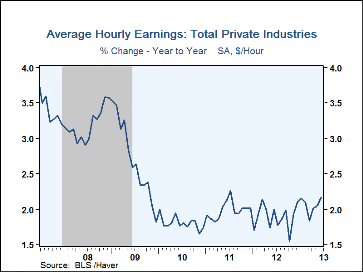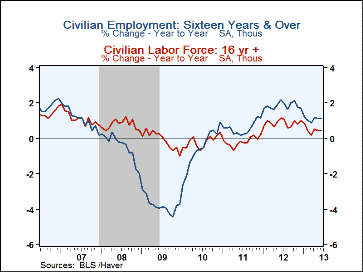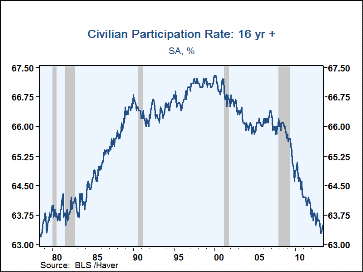 Global| Jul 05 2013
Global| Jul 05 2013U.S. Job Growth Strengthens; Unemployment Rate Is Stable
by:Tom Moeller
|in:Economy in Brief
Summary
Nonfarm payroll employment during June increased 195,000 (1.7% y/y). That followed revised gains of 195,000 and 199,000 during the prior two months, earlier reported as 175,000 and 149,000, respectively. Consensus expectations were [...]
Nonfarm payroll employment during June increased 195,000 (1.7% y/y). That followed revised gains of 195,000 and 199,000 during the prior two months, earlier reported as 175,000 and 149,000, respectively. Consensus expectations were for a 165,000 increase. Job growth in the construction and service industries continued to account for the rise in payrolls. The unemployment rate held steady at 7.6%, remaining near the cycle low. A 7.5% rate had been expected. The jobless rate on the broadest measure of unemployment, which includes marginally attached & those involuntarily working part-time, rose to 14.3%, its highest level since February.
From the establishment survey of employment, the 195,000 increase (1.7% y/y) left the three-month average change at 196,000, still off its 272,000 high early last year. Factory sector employment continued under pressure. Last month's 6,000 worker decline (0.2% y/y) was the fourth consecutive monthly drop. Construction sector employment was a bit better, but June's modest 13,000 (3.4% y/y) left the three-month average increase at a minimal 4,000 following several months of firm increase.
Private service sector jobs rose 194,000 (2.3% y/y). That left the three-month change at 202,000, improved from the 114,000 average one year ago. Hiring in leisure & hospitality hiring has been notably firm. Last month's 75,000 increase (3.7% y/y) in jobs was the strongest in nearly twenty years. Conversely, professional & business service jobs gained a lessened 53,000 (3.5% y/y). Strength in trade, transportation & utilities followed with a 45,000 increase which left y/y growth modest at 1.8%. Retail trade posted a 37,100 gain (2.0% y/y) last month which was its best since November. Health care jobs grew 23,500 (2.1% y/y), financial sector job growth picked up to 17,000 (1.4% y/y) but education services jobs fell 10,600 (+0.3% y/y). Also continuing lower were jobs in the government sector. Last month's 7,000 shortfall (-0.3% y/y) was paced by a 15,000 decline (-0.7% y/y) in state government jobs followed by a 5,000 drop (-2.3% y/y) in federal government employment. The local sector picked up some of the slack with a 13,000 rise (0.2% y/y).
The length of the average workweek was unchanged at 34.5 hours. That remained equal to the Q1 average but up from the 34.3 hours low in October. The rise in employment and the stability of hours left the index of aggregate hours-worked up just slightly month-to-month. The 2.2% gain (AR) compared to 3.6% in Q1.
Average hourly earnings within the private sector improved 0.4% last month, the best rise since November. It also led the y/y gain to 2.2%, its firmest in two years. Annual growth in earnings was led by a 4.0% gain in the financial sector and a 3.7% rise in the information sector.
From the household employment survey, the unemployment rate held m/m at 7.6% but that remained down sharply from the October 2009 high of 10.0%. The total unemployment rate, including those who are marginally attached or involuntarily working part time, rose to 14.3% but still was down from 17.1% at its peak. The average duration of unemployment fell m/m to 34.6 weeks versus 40.7 weeks at the peak in 2011.
The unemployment rate's stability reflected 160,000 rise (1.1% y/y) in employment and a 177,000 increase (0.4% y/y) in the labor force. The labor force participation rate again improved slightly m/m to 63.5%. The compares to 67.1% averaged from 1997 to 2000. The number of those not in the labor force grew 1.9% y/y, down from the 2.9% growth in 2010.
The figures referenced above are available in Haver's USECON database. Additional detail can be found in the LABOR and in the EMPL databases. The expectation figures are from Action Economics and are in the AS1REPNA database.
| Employment: (M/M Chg., 000s) | Jun | May | Apr | Y/Y | 2012 | 2011 | 2010 |
|---|---|---|---|---|---|---|---|
| Payroll Employment | 195 | 195 | 199 | 1.71% | 1.7% | 1.2% | -0.7% |
| Previous | -- | 175 | 149 | -- | 1.4 | 1.2 | -0.7 |
| Manufacturing | -6 | -7 | -7 | 0.2 | 1.7 | 1.7 | -2.7 |
| Construction | 13 | 7 | -7 | 3.4 | 2.0 | 0.3 | -8.3 |
| Private Service Producing | 194 | 207 | 205 | 2.3 | 2.2 | 1.9 | -0.1 |
| Government | -7 | -12 | 11 | -0.3 | -0.8 | -1.8 | -0.3 |
| Average Weekly Hours - Private Sector | 34.5 | 34.5 | 34.5 | 34.4 (Jun'12) |
34.4 | 34.4 | 34.1 |
| Average Private Sector Hourly Earnings (%) | 0.4 | 0.1 | 0.3 | 2.2 | 1.9 | 2.0 | 1.8 |
| Unemployment Rate (%) | 7.6 | 7.6 | 7.5 | 8.2 (Jun'12) |
8.1 | 8.9 | 9.6 |
Tom Moeller
AuthorMore in Author Profile »Prior to joining Haver Analytics in 2000, Mr. Moeller worked as the Economist at Chancellor Capital Management from 1985 to 1999. There, he developed comprehensive economic forecasts and interpreted economic data for equity and fixed income portfolio managers. Also at Chancellor, Mr. Moeller worked as an equity analyst and was responsible for researching and rating companies in the economically sensitive automobile and housing industries for investment in Chancellor’s equity portfolio. Prior to joining Chancellor, Mr. Moeller was an Economist at Citibank from 1979 to 1984. He also analyzed pricing behavior in the metals industry for the Council on Wage and Price Stability in Washington, D.C. In 1999, Mr. Moeller received the award for most accurate forecast from the Forecasters' Club of New York. From 1990 to 1992 he was President of the New York Association for Business Economists. Mr. Moeller earned an M.B.A. in Finance from Fordham University, where he graduated in 1987. He holds a Bachelor of Arts in Economics from George Washington University.


